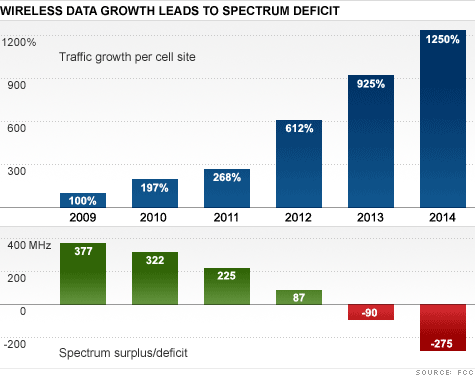The people who are using the hundreds of thousands of smartphone apps are gobbling up the available wireless frequencies. The problem, known as “spectrum crunch,” will increase your dropped calls, slow down your searches — and raise the prices you pay for service. It may also be the instigator of a major consolidation in wireless service providers. Here is an article that lays it out: http://money.cnn.com/2012/02/21/technology/spectrum_crunch/index.htm?iid=Lead.
Too bad you can’t put away extra access in your pantry like you can put away pasta sauce and spaghetti. But since you can’t, the next best thing is to look around for companies that may either get creamed by the crunch, or might be survivors — or even better, potential acquisitions. Tipping points like the one we are approaching are capable of creating 4-baggers for savvy investors.
Please do your own diligence. We do not recommend stocks; we only write about companies we find interesting. We do not represent any of the companies in this article and we do not own the stocks or intend to buy them.
Ottawa-based DragonWave Inc (Nasdaq: DRWI; http://www.dragonwaveinc.com/) makes equipment that transmits signals with radio frequencies (wirelessly) for Ethernet networks AND for cellular providers. Some of their products are particular applicable to the sometimes-problematic “backhaul” wireless route — the part of the service where you send an email or VoIP call back to your provider. Founded in 2000, DRWI experienced a drop-off in revenue in 2011, but their margins held steady in the low 40s, and their cash on hand as of September 30, 2011, was over $60 million, after losing $20 million in the first 9 months (they had reported a profit the year earlier). Shares are selling at $4.65 vs a year-high of $8.75, which probably reflects the disappointing revenue and losses. Market cap is about $164 million, and daily stock volume is a touch over 220,000 shares.
Edinburg VA-based Shenandoah Telecommunications Co (Nasdaq: SHEN; http://www.shentel.com/) provides both wired and wireless service from about Harrisburg PA down to Harrisonburg VA, just northwest of Charlottesville. SHEN revenues for the 3rd quarter of 2011 were up a booming 18% to about $63 million with quarterly EPS of $0.13. PCS revenues are up 75% in the last year or so. From a 50,000-foot view, SHEN looks like it could be tucked into a larger telcom company fairly easily from an operational point of view, though there has not been any move to take them over. Shares are selling for $10.91 vs a 52-week range of $9.01 to $19.08, so if you like the business, it is at the low end of the trading range now. Market cap is about $257 million, which is a touch over 1x revenues based on the 3rd quarter, and daily trading is about 75,000 shares. Could be unrealized value there.
San Diego-based Novatel Wireless (Nasdaq: NVTL: http://www.novatelwireless.com/) is an old-timer in this space, having been founded in 1996. NVTL is a developer of wireless technologies to 4G (and beyond), with a strong portfolio of patents to its credit. They target the mobile workforce, public safety markets, stolen-auto recovery, POS and ATM functions, and lots of other applications. Including a proforma acquisition, Q3 revenue was $113 million vs $75.6 million in 2010’s Q3 with EPS of $0.14, and they reported cash & marketable securities of about $54 million. The stock is trading at about $3.42 vs a 52-week high of $6.99 for a market cap of just $110 million, which is less than Q3 revenue (hmmmmm, veddy interesting). Daily trading volume is around 240,000 shares.
Waynesboro VA-based NTELOS Holdings Corp (Nasdaq: NTLS; http://www.ntelos.com/) is a wireless service provider in parts of North Carolina, Virginia, West Virginia, Kentucky, Ohio and Pennsylvania, selling some of its services and capacity to Sprint Nextel. NTLS spun off its wireline operations as Lumos Networks (Nasdaq: LMOS), effective last Halloween. Q3 revenues were about $156 million, putting it on track for about $600 million or more for the year. Their YE earnings are due to be announced Feb 29, 2012. They reported a Q3 profit of $0.63 per share, and paid a quarterly cash dividend of $0.42 in January. All of that makes their market cap of $516 million more interesting. Stock is selling for $24.69 on volume of about 95,000 shares, with that dividend yield at about 1.7%, which is better than being hit in the head for sure.
Finally you might have a look at San Diego-based Leap Wireless International (Nasdaq: LEAP; http://www.leapwireless.com/). LEAP provides wireless services in the US under the Cricket brand, and offers Muve Music unlimited music downloads in some markets. For the full year 2011, LEAP reported revenue of $3.07 billion with a net loss per share of $1.10, but adjusted earnings of about $135 million on a non-GAAP but commonly used calculation similar to EBITDA. They had $750 million in cash. All those numbers make one do a double-take at their market cap of $771 million, which is only $21 million more than their cash on hand. LEAP shares are at about $9.78 vs a year-high of $17.66, with average daily volume of 1.8 million shares. That is the sort of valuation that could lead to a profitable exit for savvy investors — but do your own work before buying, please. We are not financial advisors in any way, shape or form.
